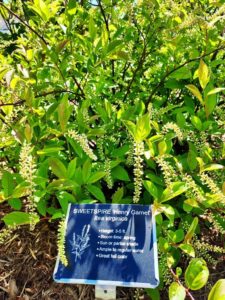The garden is lush and beautiful and full of life. Butterflies flit from blossom to blossom. Bees of all types are busy pollinating flowers. Birds swoop down to capture caterpillars to feed their young. The garden provides food for animals through all the seasons, while providing ever-changing color and interest to its owners. What makes this garden so special? Native plants.
its owners. What makes this garden so special? Native plants.
Gardeners everywhere are discovering, or rediscovering, that native plants are the key to a vibrant landscape. Over countless years, plants and animals evolved to support one another.
“Plants native to our area are able to provide wildlife with the food, shelter, and complex relationships they need to thrive,” said Northern Neck Master Gardener Carol Martin. “Birds need thousands of caterpillars to raise each brood. These caterpillars, in turn, feed only on certain native plants, so your landscape needs native plants to support the bird population.”
People have become accustomed to orderly gardens filled with exotic (non-native) plants, often chosen because their leaves do not tempt local insects. They also think that native gardens cannot give the same sense of peace, beauty, and satisfaction. One look at the Northern Neck Master Gardeners’ Living Shoreline Garden at the Reedville Fishermen’s Museum proves this is not true. Most of the plants in the garden are natives. Signage gives the common and scientific name and notable characteristics of each native so that visitors to the garden can easily identify their favorites. The garden provides an ever-changing kaleidoscope of colors and textures and shows that native gardens can be as orderly or as uncontrolled as you would like.
Recent research shows that a landscape can be 30% non-native and yet still provide the ecosystem need
ed by wildlife, so you do not have to get rid of your favorite plants. “It’s easy to start using natives,” said Martin. “You can add natives gradually to existing beds or create new beds using natives. We strongly encourage people to use native plants whenever possible.”
Martin says that it is easy to find natives to use instead of more familiar plants. “Use winterberry holly for its red berries instead of nandina, or Virginia sweetspire for its bright red leaves in fall instead of burning bush, or fringetree instead of Bradford pear. Add native plants to your garden. You won’t be disappointed.”
